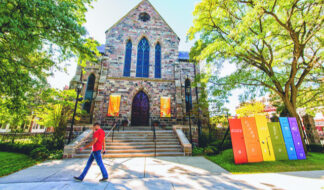MONTREAL – As a street performer in the late 1970s, Carmen Ruest would often pass the hat to earn enough money to fund that evening's meal. But never in her wildest dreams did the young Canadian dancer ever envision that one day she'd play a pivotal role in a multimillion dollar theatrical phenomenon that has traveled to more than 100 countries and played to more than 70 million people of all ages and cultures since its inception in 1984.
"We were really just a bunch of artists living together and being together doing one project at a time, not knowing what we were going to do next," recalled Cirque du Soleil's director of creation from her office in Montreal. "It was really free and crazy. It was that '70s feeling – of peace and love. We were of that generation that in those years believed anything was possible. We didn't care about the money; we were just putting everything we had into our art."
And they still are, as six of the original two-dozen artists – including Founder and CEO Guy Laliberte and Senior Vice-President Gilles Ste-Croix – are still with the company.
Cirque, with 15 shows currently performing worldwide, has its roots in the European-style summer festivals that are popular in cities and towns all across Quebec, Ruest explained. "Every year in every big city where there are tourists visiting they have little festivals (with) street performers. I started as a dancer, and adapted it with my friends that were doing circus music in the streets."
But it was at the Bread and Puppet festival in nearby Glover, Vermont where Ruest first met Ste-Croix. There they saw for the first time how performers were using stilts in theater. "So we had this idea to write a show about a guy who became a legend in Quebec provincial folk culture – a guy who existed for real who loved to run and had special legs."
So Ste-Croix "gathered together a bunch of performers" and founded the Echassiers de Baie-Saint-Paul and organized a street festival called the Fete foraine de Baie-Saint-Paul. This eventually led to the creation of Cirque du Soleil with Laliberte in 1984.
The fledgling company grew quickly over the years – from 73 employees in 1984 to more than 3,800 today. And Ruest believes she knows why: Creativity is its driving force. "When the company was created, the most important thing was the show. And it's always stayed like that."
An artistic team is assigned to each of the company's shows, she said, with a mandate "to keep the show alive and shining as if we had created it last week. That's what is really the success of Cirque: to take the risk of putting creativity first – no matter what."
Saltimbanco
The latest Cirque show to hit Metro Detroit is actually one of its earliest. "It's its second reincarnation," Ruest said of "Saltimbanco," which, from the Italian "saltare in banco," means "to jump on a bench." "It's a restaging."
The original production was created in 1992 and quickly became a family favorite. But it stopped touring in 1997, Ruest said, so the company could concentrate on its first resident production, "Mystere" in Las Vegas, and another in Orlando. "We had a lot on our plates."
But the Asian market came calling, so "Saltimbanco" was restaged with an all-new cast in 1998. "It opened a lot of new markets for us," Ruest acknowledged. "It became our classic signature show."
Why that is can easily be explained, Ruest said. "It's a show about hope – and it's a bowl of joy."
The show is described as an allegorical and acrobatic journey into the heart of a city. And it's based upon the urban experience of the late 20th century. "In the 1990s, a lot of people in the villages and small cities were migrating to the big cities. This is about how do you change yourself and how do you connect with others when you move to another city."
For the current tour, which began early last year, the production was resized for larger arena performances. "I was lucky to get creators from '92 to come back and help us restage the whole thing," Ruest said. "For me, it was really important to keep the art, the soul and the roots of when it was created in '92."
The production is its own small city: It features 47 performers, and requires 20 specialists and a dozen 53-foot trailers to move from town to town.
Ruest recommends the colorfully baroque and energetic show for people ages three and above. And she's pleased that the show is still entertaining audiences. "The acts are amazing. And it's a good way to discover Cirque for the first time."
(FOR "REVIEW BOX")
PREVIEW:
'Saltimbanco'
Cirque du Soleil at Joe Louis Arena, Detroit. Tue.-Sun., Jan 23-27. Tickets: $37.50-$67.50. For information: 313-471-6611 or http://www.olympiaentertainment.com.









